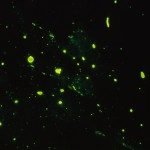Lien vers Pubmed [PMID] – 27977811
PLoS Pathog. 2016 Dec;12(12):e1006041
The natural evolution of rabies virus (RABV) provides a potent example of multiple host shifts and an important opportunity to determine the mechanisms that underpin viral emergence. Using 321 genome sequences spanning an unprecedented diversity of RABV, we compared evolutionary rates and selection pressures in viruses sampled from multiple primary host shifts that occurred on various continents. Two major phylogenetic groups, bat-related RABV and dog-related RABV, experiencing markedly different evolutionary dynamics were identified. While no correlation between time and genetic divergence was found in bat-related RABV, the evolution of dog-related RABV followed a generally clock-like structure, although with a relatively low evolutionary rate. Subsequent molecular clock dating indicated that dog-related RABV likely underwent a rapid global spread following the intensification of intercontinental trade starting in the 15th century. Strikingly, although dog RABV has jumped to various wildlife species from the order Carnivora, we found no clear evidence that these host-jumping events involved adaptive evolution, with RABV instead characterized by strong purifying selection, suggesting that ecological processes also play an important role in shaping patterns of emergence. However, specific amino acid changes were associated with the parallel emergence of RABV in ferret-badgers in Asia, and some host shifts were associated with increases in evolutionary rate, particularly in the ferret-badger and mongoose, implying that changes in host species can have important impacts on evolutionary dynamics.


